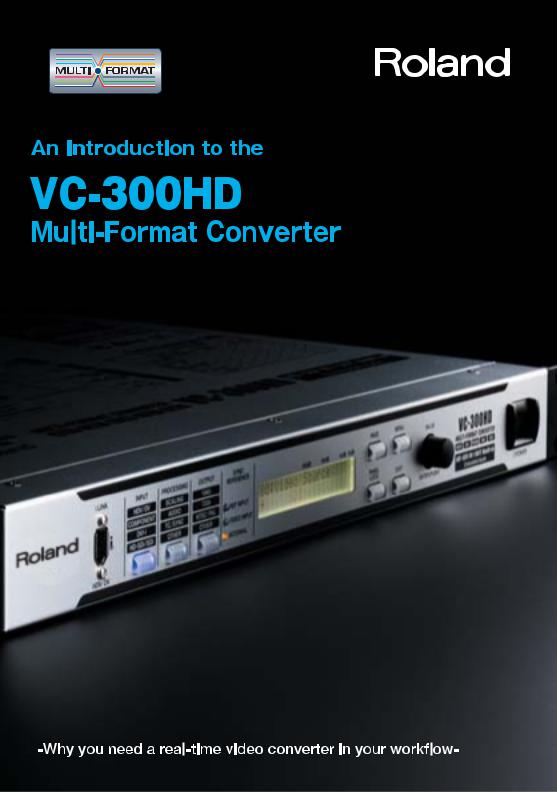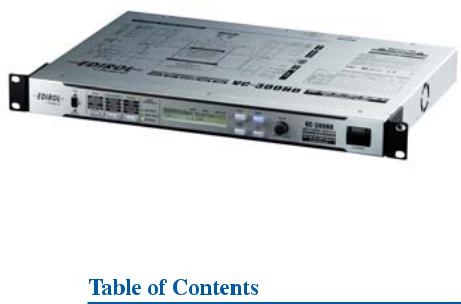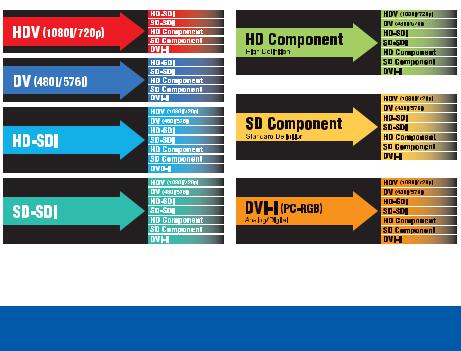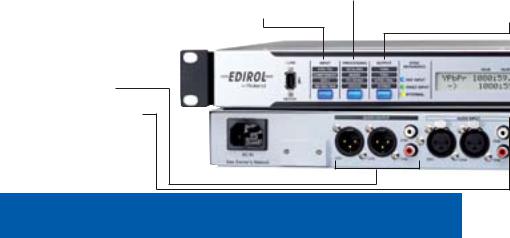Roland VC-300HD User Manual


Now that digital broadcasting service areas are expanding, and with the appearance of high-definition content on Blu-ray and HD DVD media, there is a strong demand for high definition content production.
Until these recent developments, HD content production had been comparatively simple, with the source of input being mainly limited to HD camera recordings. With television shifting to high definition and the rapid spread of high-definition video cameras for consumer use, location shooting in consumer HDV format with inexpensive cameras is becoming more popular. Meanwhile the transition to a tapeless era for broadcasting is underway. Overall, an extremely complex situation has arisen. If this had been a complete shift towards digital data in files handled by codecs, IP and the world of networking, this may not have presented so many challenges. In reality, we cannot ignore the world of real-time transmissions in which data streams of various formats are distributed via cable connection.
When viewed as, “Hi-Def”, the various HD formats probably look the same to many. In reality, however, video from different sources are likely to have different resolutions, bit rates, and frame rates. Moreover, when these are transmitted, it may be physically impossible to access files with different formats. It is getting so that you can’t easily manage simple tasks like dubbing or monitoring.
What is needed for this world of many formats is a multi-format converter that can convert from many formats to any other form. While it is possible to get devices that can specifically convert between just about any of the existing formats, for example between component and SDI, they are not cost effective or bi-directional.
To resolve the various challenges, Roland has designed the Edirol VC-300HD. This product has been shipping since March 2007 and has already proved to be very popular. This has occurred because production studios, broadcast facilities and duplication houses are pro-actively looking for multi-format converter solutions to avoid format compatibility issues and speed up the conversion process, saving time and money.
This document is designed for people who are considering the purchase of a multi-format converter. Here you will discover detailed information about the features and benefits of the VC-300HD. We hope that you will find valuable and informative in this challenging world of multi-formats.

|
Introduction |
|
|
|
|
|
2 |
|||||||
|
Why you need a real-time converter |
|
|
|
|
|
4 |
|||||||
|
Support for various formats |
|
|
|
|
|
5 |
|||||||
|
Actual conversion procedure |
|
|
|
|
|
6 |
|||||||
|
Picture quality evaluation |
|
|
|
|
|
8 |
|||||||
‘The Processing’- More than just a converter |
|
|
|
|
|
10 |
||||||||
|
Superior picture quality after down conversion - Interview Shinji Kobukata |
|
12 |
|||||||||||
|
Making full use of HDV - Interview with a VC-300HD developer |
|
14 |
|||||||||||
|
System proposal - Flexible format conversion is the key |
16 |
||||||||||||
|
Input/Output specifications |
|
|
|
|
|
18 |
|||||||
|
Main specifications and connectors |
|
|
|
|
|
19 |
|||||||
|
|
|
|
|||||||||||
|
|
Writer: Nobuyoshi Kodera |
Cover photos: Shinya Aizawa |
|||||||||||
The Japanese original book was issued asa supplement of “Gekkan Video α” on June 1st, 2007.
3

Why you need a real-time converter
In no time at all, formats for HD recording have multiplied. Although the mainstream format for delivery of commercial broadcasting is HDCAM, an infrastructure to accommodate HDCAM-SR is also gradually coming into mainstream. On the other hand, the SD format is still being widely used for news coverage and the introduction of non-linear HD media such as XDCAM and P2 is being considered. As long as the video is output as HD-SDI, interoperability is possible.
It is not unusual for TV programs and promotion videos to be shot and recorded with cameras that use consumer HDV video formats. Moreover, from the adoption of SD, real time output from PC monitors was being recorded and broadcasted. Of course, this method is also effective in an HD environment. No matter how quickly you may have embraced HD, however, the advantages of non-linear editing are often hindered. Whenever real-time multi-format conversion is unavailable, you can suffer from three types of loss.
Time wasted in conversion process
In some cases today, production companies are loading footage that needs converting to a nonlinear editing system (NLE), and using software to convert to the desired format. This methodology is not practical or an efficient use of your NLE system. The process of loading each time into the NLE, rendering with software and then outputting may seem quick and convenient at first glance, but in many it just ends up taking more time than initially expected.
Unnecessary investment in equipment
Conversion can tie up the entire NLE for long
periods of time, and results in a shortage of temporary drive space and increases costs. Moreover, converting using an NLE system is a non-editing task that can unnecessarily tie up an expert editor. Thus, all the temporary storage space, which you need for a margin of safety during conversion, can add significantly to operating costs.
Monitoring various video formats is another issue. A monitor compatible with the format of the data needing conversion may not always be readily available. HD video can be checked on a PC monitor, but if you want to check output on a projector or consumer TV, you can only use HDSDI or HDV.
Lost business opportunities
In a fast paced production environment where speed, ease of use and reliability are essential, format compatibility can kill a project. As a result, we tend to avoid dealing with formats we are not sure about or we consider to be a hassle. If your studio doesn’t deal with certain formats you may find yourself turning down business.
The production side examines work right down to the fine details and trouble avoidance is given high priority. If you have long-term relationships with clients, both sides know what the other can and cannot do. Of course, this may seem like an ideal way of working, but it can also mean loss of future business by refusing new clients with special format or conversion requirements. If your company can only deal with a limited number of formats it always runs the risk of not being competent to deal with large projects using formats beyond your capabilities.
4

Multi-format conversion options
Support for various formats
The VC-300HD enables conversion between many all of the formats currently used in video production. It is a multi-format converter. Four connector types provide different data sources and destinations: IEEE1394, analog component, SDI, and DVI-I. HDMI connectivity is enabled through the use of a DVI-I conversion cable.
These different connectors provide access to a diverse variety of HD, SD and other resolutions. Naturally, to ensure conversion between resolutions, up conversion and down conversion are supported. Even in HD format, conversion from 720p to 1080i is far from unusual. This type of resolution conversion plus Interlace/ Progressive conversion is possible with the VC300HD.
Moreover, output to a PC monitor can be converted to HDV and HD-SDI output. This
makes it possible to capture PowerPoint slides and other software applications as immediately usable video content. Going the other way, video pro VCR content can be converted to data that can be viewed on PC monitors, via projectors, and on consumer TV screens.
Moreover, while China is geographically close to Japan, China is in the PAL region. When the 2008 Olympics are held in Beijing, Japan is bound to have to quickly deal with a lot more PAL content. The VC-300HD is not limited to NTSC format. It takes the different frame rates and resolution from PAL to NTSC output and vice versa. Up to now, no other converter has been available that enables you to convert just about all existing formats and provide bidirectional conversion.
5

Signal processing is automatically
selected based on selected input and output.
Select input source.
The built-in audio delay for frame-accurate sync.
Supports embedded audio with
High Quality A/D - D/A conversion.
Actual conversion procedure
What does format conversion actually involve with the VC series? It’s so simple that almost anyone who has operated video equipment can do it just by looking at the panel and selecting the settings. For instance, let’s see how HDV content is converted and output to other formats.
Using a Firewire cable, connect the HDV camera output to the i.LINK input. While there is an i.LINK port at the rear of the unit, an i.LINk connector was added to the front for convenience. However, you can only use one at time, and one i.LINK port must be closed when the other is in use. You can leave the other output terminals - HD-SDI, DVI-I and analog component - permanently connected to devices or monitors.
Three function buttons on the front panel from left to right are labeled. From the left they are labeled INPUT, PROCESSING, and OUTPUT. After you press INPUT, it lights up blue. The display shows the name of the input connector being used. The unit automatically senses the type of incoming signal. All you have to do is check and select the active input connection.
Turning the knob on the right, you cycle to i.LINK and select by pushing the knob. All the basic selection operations are done by turning the knob and pushing into select the displayed item.
Let's now take a look at the OUTPUT function. Once you selected the output format, the converter will automatically convert and output the video format desired. If the unit’s automatic settings are acceptable, there is no need to access the PROCESSING button to adjust the parameters.
Furthermore, the VC-300HD can output the converted data via any of the connectors. For example, if you select 1080/59.94i, full HD video can be sent out parallel via the Analog Component, HD-SDI, and DVI-I connectors. That means that you don’t have to actually select the output connector. This feature is convenient when you want to send converted video output to more than one device. Naturally, if you select 480/59.94i, the video is down converted to SD and can be output via all the connectors. In this instance, HD-SDI is automatically output as SDSDI.
6
